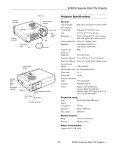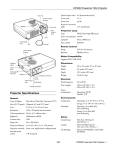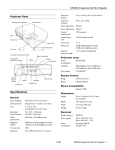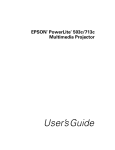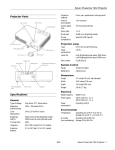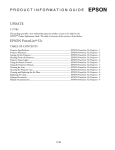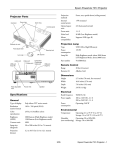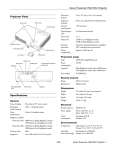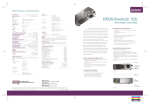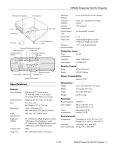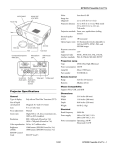Download Epson PowerLite 735c Specifications
Transcript
EPSON PowerLite 735c Projector Card slot Card reader access light Control panel Security lock Contrast ratio 400:1 Image size 30 to 300 inches Projection distance 3.2 to 38.5 feet (0.96 to 11.7 meters) Air filter Projection methods Front, rear, upside-down front (ceiling mount), and upside-down rear Internal sound system 1 W monaural Optical aspect ratio 4:3 (horizontal:vertical) Zoom ratio 1:1.16 Noise level 39 dB Keystone correction angle ±15° vertical (maximum) Focus ring Projection Lamp Foot release lever Type Power consumption 150 W Zoom ring Lens cover UHE (Ultra High Efficiency) RC receiver Adjustable foot Lamp life About 1500 hours Part number V13H010L18 Remote Control Computer/ Component Video port S-Video port Video port Audio-In port USB port Range 20 feet (6 meters) Battery CR2025 lithium Mouse Compatibility Supports USB Dimensions Power inlet Remote control holder Speaker Remote control receiver Height 2.8 to 3.1 inches (70 to 78.5 mm) Width 10.9 inches (276 mm) Depth 7.5 inches (190 mm) Weight 4.4 lb (1.9 kg) Electrical Rated frequency 50 to 60 Hz Power supply 100 to 120 VAC, 3.1 A 200 to 240 VAC, 1.5 A Projector Specifications Power consumption General Type of display Poly-silicon Thin Film Transistor (TFT), active matrix Size of LCD panels Diagonal: 0.9 inch (22.9 mm) Environmental Lens Temperature Resolution F=1.9 to 2.1, f=31 to 36 mm Operating: 41 to 95 °F (5 to 35 °C) Storage: 14 to 140 °F (–10 to 60 °C) 1024 × 768 pixels (native format) Humidity Color reproduction 24 bit, 16.8 million colors Brightness Operating: 225 W Standby: 5.5 W Network standby: 35 W 2000 lumens (ANSI) Operating: 20 to 80% RH, non-condensing Storage: 10 to 90% RH, non-condensing 2/03 EPSON PowerLite 735c Projector - 1 EPSON PowerLite 735c Projector Safety United States FCC 47CFR Part15B Class B (DoC) UL1950 Rev. 3 Canada ICES-003 Class B CSA C22.2 No. 950-95 (cUL) CE Marking Directive 73/23/EEC, 89/336/EEC EN 55022, EN 55024 Compatible Video Formats To project images from a computer, the computer’s video card must be set at a refresh rate that’s compatible with the projector; see the following table for compatible formats. As noted below, some images are automatically resized to display in one of the projector’s “native” formats (such as XGA). In addition, the frequencies of some computers may not allow images to display correctly; see your computer’s documentation for details. Mode Refresh Rate (Hz) Resolution VGAEGA 70 640 x 350* VGA—60 VESA—72 VESA—75 VESA—85 60 72 75 85 640 x 480* 640 x 480* 640 x 480* 640 x 480* SVGA—56 SVGA—60 SVGA—72 SVGA—75 SVGA—85 56 60 72 75 85 800 x 600* 800 x 600* 800 x 600* 800 x 600* 800 x 600* * Mode Refresh Rate (Hz) Resolution NTSC NTSC 4:3 PAL M-PAL N-PAL PAL—60 SECAM 60 60 50 60 50 60 50 — — — — — — — HDTV (480i) HDTV (480p) HDTV (720p) HDTV (1080i) HDTV (1080i) 60 60 60 60 50 640 x 480* 640 x 480* 1280 x 720* 1920 x 1080* 1920 x 1080* The image is resized using EPSON’s SizeWise™ Technology. Computer Connector Pin Assignments The Computer1/Component Video port is a female video RGB, 15-pin micro-D-style connector. Here are the pin assignments: Input pin Computer connector signals 1 Red video 2 Green video 3 Blue video 4 GND 5 GND 6 Red GND 7 Green GND 8 Blue GND XGA—43i XGA—60 XGA—70 XGA—75 XGA—85 43 60 70 75 85 1024 x 768 1024 x 768 1024 x 768 1024 x 768 1024 x 768 9 Reserved SXGA1—70 SXGA1—75 SXGA1—85 70 75 85 1152 x 864* 1152 x 864* 1152 x 864* 10 Synchronous GND 11 GND SXGA2—60 SXGA2—75 SXGA2—85 60 75 85.94 1280 x 960* 1280 x 960* 1280 x 960* 12 SDA 13 Horizontal sync/ composite sync 14 Vertical sync 15 SCL SXGA3—43i SXGA3—60 SXGA3—75 SXGA3—85 43 60 75 85 1280 x 1024* 1280 x 1024* 1280 x 1024* 1280 x 1024* UXGA—48i UXGA—60 48 60 1600 x 1200* 1600 x 1200* Positioning the Projector MAC13 MAC16 MAC19—60 MAC19 MAC21 67 75 59 75 75 640 x 480* 832 x 624* 1024 x 768 1024 x 768 1152 x 870* ❏ Place the projector on a sturdy, level surface, between 3 and 38.5 feet from the screen. Place it within 10 feet of an electrical outlet or extension cord and 5 feet of your computer or video source. ❏ Allow space for ventilation around and under the projector. ❏ Place the projector directly in front of the center of the screen, facing the screen squarely. Otherwise, your image will not be square. 2 - EPSON PowerLite 735c Projector 2/03 EPSON PowerLite 735c Projector Turning On the Projector Use the figure below as a guideline to help you determine how far from the screen to place the projector. Image size generally increases with distance, but may vary depending on how you position the zoom ring and whether you have adjusted the image size with other settings. Follow these steps to plug in and turn on the projector: 1. Remove the lens cap. Caution: Do not use the projector with the lens cap in place. The heat generated by the lens can damage the cap. 2. Connect one end of the power cord to the projector’s power inlet. 33 to 38.5 ft 6.5 to 7.5 ft 3 to 4 ft Distance from screen If you place the projector below the level of the screen, you’ll have to tilt it up by extending the feet as shown on page 5. This causes the projector to lose its square shape, but the projector automatically compensates. You can manually correct the distortion by pressing the Keystone button as described on page 5. 3. Connect the other end to an electrical outlet. The P power light on top of the projector turns orange, indicating that the projector is receiving power but not yet turned on. 4. Press the red P Power button on top of the projector. You can also use the P Power button on the remote control. Power button Ideal height The P power light flashes green as the projector warms up, and the projection lamp comes on in about 40 seconds. Then the power light stays green. If you place the projector level with the bottom of the screen, the image will be square and you won’t have to adjust it. If you place the projector higher than the bottom of the screen, the image will still be square, but you won’t be able to fill the whole screen with the image. Warning: Never look into the lens when the lamp is on. This can damage your eyes. 5. Select the source as follows: ❏ On the control panel, the Source button switches between equipment connected to the Video, S-Video, and Computer/Component Video ports, or to EasyMP™ (for wireless network and memory card presentations). Starting Up the Projector Make sure your projector and other equipment are set up and connected correctly. Then turn on your projector, as described below, followed by any equipment you’ve connected to it. You can turn on your computer and video equipment in any order, but if you have both a computer and video source connected, you may have to switch to the desired source as described on page 4. ❏ On the remote control, the Comp/EasyMP button switches between a computer source and EasyMP. The S-Video/Video button switches between an S-Video source and standard composite video source. 2/03 EPSON PowerLite 735c Projector - 3 EPSON PowerLite 735c Projector If you’re using a laptop with Macintosh® OS 9.x: If a projected image fails to appear, see “What To Do If You See a Blank Screen” below for help. You may need to set up your system to display on the projector screen as well as the LCD screen. Follow these steps: Starting EasyMP 1. From the Apple menu, select Control Panels, then click Monitors or Monitors and Sound. 1. Select EasyMP as the source by pressing the Source button on the projector or the Comp/EasyMP button on the remote control. 2. Click the Arrange icon. 2. Insert either the EPSON 802.11b card (for wireless presentations) or a memory card (for computer-free presentations) into the projector’s card slot. (If you do not insert a card, you see a screen prompting you to do so.) Click here For detailed instructions on running your EasyMP presentation, see “Projecting Wirelessly in Ad Hoc Mode” on page 7 or “Presenting from a Memory Card” on page 8. Drag one monitor icon on top of the other What To Do If You See a Blank Screen If you see a blank screen or a blue screen with the message No Signal after turning on your computer or video source, try the following: ❏ Make sure the cables are connected correctly. 3. Drag one monitor icon on top of the other. ❏ Make sure the power light is green and not flashing and the lens cover is off. If the Arrange option isn’t available, you may need to select one of the Simulscan resolution settings: ❏ Try restarting your computer. 1. Click the Monitor icon if necessary. ❏ Press the Source button on top of the projector or the Comp/EasyMP or Video/S-Video button on the remote control to select the correct source. (Allow a few seconds for the projector to sync up after pressing the button.) Click here If you’re using a PC laptop: ❏ Hold down the Fn key and press the function key that lets you display on an external monitor. It may have an icon such as or it may be labeled CRT/LCD. Allow a few seconds for the projector to sync up after pressing it. Check your laptop’s manual or online help for details. Select a Simulscan resolution On most systems, the or CRT/LCD key lets you toggle between the LCD screen and the projector, or display on both at the same time. 2. Select a Simulscan resolution as shown. (Allow a few seconds for the projector to sync up after making the selection.) ❏ Depending on your computer’s video card, you might need to use the Display utility in the Windows® Control Panel to make sure that both the LCD screen and external monitor port are enabled. See your computer’s documentation or online help for details. 4 - EPSON PowerLite 735c Projector 2/03 EPSON PowerLite 735c Projector You can also change the image size by moving the projector closer to or farther away from the screen. You can use the E-Zoom + or – buttons on the remote control to zoom in or out on a portion of the image. If you’re using a laptop with Macintosh OS X: You may need to set up your system to display on the projector screen as well as the LCD screen. Follow these steps: 1. From the Apple menu, select System Preferences, then select Displays. Adjusting the Height of Your Image 2. Make sure the VGA Display dialog box is selected. If the image is too low, you can raise it by extending the projector’s feet. 3. Click the Arrange tab. 1. Stand behind the projector. Push the foot release levers on either side and lift the front of the projector. This unlocks the feet. Select the VGA Display dialog box Make sure Mirror Displays is checked Caution: Do not hold the projector by the lens; this can damage it. 4. Make sure the Mirror Displays checkbox is selected. 2. Once the image is positioned where you want it, release the levers to lock the feet in position. Adjusting the Image 3. To fine-tune the height of the image, rotate the thumb wheels attached to the projector’s feet. Once you see your image, you may need to make certain adjustments: If the image is no longer square after raising it, see the next section. ❏ To focus or zoom the image, see below. ❏ If the image is too high or too low, see “Adjusting the Height of Your Image” to the right. Adjusting the Image Shape If the projected image isn’t square or has a “keystone” shape, do the following: ❏ If the image isn’t square, see “Adjusting the Image Shape” to the right. ❏ If your image looks like or , you’ve placed the projector off to one side of the screen, at an angle. Move it directly in front of the center of the screen, facing the screen squarely. ❏ If the computer image displays incorrectly, see page 6. Focusing and Zooming Your Image ❏ If your image looks like or , press the left or right side of the projector’s Keystone button to correct the shape of the image. After correction, your image will be slightly smaller. Use the tab to rotate the focus ring to sharpen the image. Focus ring Zoom ring Use the Keystone button to correct distortion Use the tab to rotate the zoom ring and reduce or enlarge the image. 2/03 EPSON PowerLite 735c Projector - 5 EPSON PowerLite 735c Projector 4. Turn off and disconnect any equipment plugged into the projector. You can also use the remote control to access the projector’s Setting menu, where you can perform keystone correction or enable the Auto Keystone option. 5. Replace the lens cap, retract the feet, and unplug the power cord. Correcting Computer Images Caution: To avoid damaging the projector or lamp, never unplug the power cord when the power light is green or flashing orange. If you’re connected to a computer and the image doesn’t display correctly (for example, part of the screen is cut off), press the Auto button on the remote control. This automatically adjusts the picture quality and resolution so that the image fits properly on the screen. 6. Store the projector in the case that came with it or in a similar protective case. Shutting Down the Projector Using the Remote Control When you’ve finished using the projector, follow the recommended procedure to shut it down. This extends the life of the lamp and protects the projector from possible overheating. The remote control lets you access most of your projector’s features from anywhere in the room (up to 20 feet away). You can use it to turn the projector on and off and zoom the image, for example. Note: When the projector has not received any input signals for 30 minutes, it automatically turns off the projector lamp and enters standby mode. This conserves electricity, cools the projector, and extends the life of the lamp. If you are done using the projector, unplug the power cord. If you want to start projecting again, press the Power button. Page up Page down Page up Power Page down Comp/EasyMP S-Video/Video Color Mode Comp/EasyMP 1. If you’re using a computer or laptop, shut it down first. Otherwise you may not be able to see your computer’s display to shut it down properly. Menu A/V Mute Freeze Menu S-Video/ Video source Color mode Freeze E-Zoom 2. To turn off the projector, press the red P Power button on the projector or remote control. You see a confirmation message. (If you don’t want to turn it off, press any other button.) Power A/V mute Zoom out Zoom-in Arrow buttons Auto Enter Auto ESC Esc Power button Enter This table summarizes the functions on the remote control. Button 3. Press the P Power button again. The power light flashes orange for about 90 seconds as the projector cools down. When the projector has cooled, the orange light stays on and the exhaust fan shuts off. If you want to turn the projector on again, wait until the orange light stops flashing. Then press the P Power button. 6 - EPSON PowerLite 735c Projector 2/03 Function Page up Returns to the previous image in a slideshow. Page down Advances to the next image in a slideshow. Power Turns the projector on or off. Color Mode Adjusts the vividness of the image color. You can select from six settings, and save a different setting for each computer and/or video source. Comp/EasyMP Switches between computer source and EasyMP. S-Video/Video Switches between an S-Video source and a standard composite video source. Freeze Halts action. Press again to resume action. Menu Displays menus for changing projector settings. EPSON PowerLite 735c Projector Button Function A/V Mute Turns off audio and video, displaying the black, blue, or user logo background. Press again to turn audio and video back on. Zoom-in Enlarges the image size. Zoom-out Reduces the image size. Arrow buttons Use to navigate menus or to use the remote as a mouse pointer when the projector is connected to a computer with the mouse cable. Enter Selects a highlighted menu option, or advances to the next image in a slideshow. Auto Optimizes the computer image. Esc Stops the current function. Pressing Esc while viewing a menu displays the previous menu. Pressing while viewing a slideshow exits the slideshow. Projecting Wirelessly in Ad Hoc Mode Follow these steps to project wirelessly if you’ve already configured your computer and projector to work in ad hoc mode. 1. Turn on the projector as described on page 3. 2. Select EasyMP as the source, using either the Comp/ EasyMP button on the remote control or the Source button on the projector (see page 7). 3. If you haven’t already done so, insert the EPSON 802.11b card with the blue label facing up. Note: The projector might not respond to remote control commands in these conditions: the battery is weak; ambient light is too bright; a certain type of fluorescent light is present; a strong light source (such as direct sunlight) shines into the infrared receiver; or other equipment emitting infrared energy is present (such as a radiant room heater). Correct these conditions to use the remote control. Insert card into card slot Using the Control Panel Note: Only the EPSON 802.11b card is guaranteed to work. Other brands are not compatible. You see a message that the network screen is ready to connect. At the bottom of the screen, you see the projector name and ESSID identifier. 4. From the Start menu, select EMP NS Connection. You see this screen: The following table summarizes the functions of the buttons on top of the projector. Button Function Power Turns the projector on or off. Help Displays the online help menu. Source Switches between Computer, Video, S-Video, and EasyMP (for wireless network and memory card presentations). Enter Selects a menu option when the Help menu is displayed. Keystone Adjusts a trapezoid-shaped distorted image; corrects up to a ±15° tilt. Select Scrolls through options when the Help menu is displayed. Select your projector If the connection is working properly, you see your projector listed as shown. If you have additional projectors on the network, they are also listed. 2/03 EPSON PowerLite 735c Projector - 7 EPSON PowerLite 735c Projector If you don’t see any projectors listed, click Option, then click Switch LAN. Make sure the correct wireless network device is selected. (Sometimes another network device, such as an Ethernet card, may be selected.) If you don’t see your wireless device but you’re sure you configured it correctly, you may need to restart your computer. Presenting from a Memory Card The projector’s EasyMP feature lets you give presentations from a memory card. Using EMP SlideMaker software, you can easily convert a PowerPoint® file into a format called a scenario. You can include any combination of PowerPoint slides, JPG image files, and BMP graphics files. 5. Once the name of your projector appears, select it and click Connect. If more than one projector is listed, you can select additional ones to connect to them at the same time. Once the scenario is created, you can download it to a memory card, insert the card in the projector, and play the scenario. 6. If you see a window prompting you for a keyword, enter the four-digit number displayed by the projector and click OK. To use EMP Slidemaker, you’ll need a memory card and a card reader on your computer. Depending on the type of card, you may also need an adapter to use it with the projector. The following standard Type II memory cards are supported: Once the connection is established, you see your computer’s image transmitted to the projector, along with a floating toolbar. ❏ CompactFlash™ ❏ SmartMedia™ ❏ Memory Stick™ ❏ Microdrive™ ❏ ATA flash (does not require a PC card adapter) Click here to minimize ❏ Secure Digital ❏ MMC Converting a PowerPoint File to a Scenario 1. Locate the PowerPoint file you want to use. 2. Make sure the EMP SlideMaker program is closed. Then drag your PowerPoint file icon on top of the EMP SlideMaker icon. 7. From the toolbar, you can access these features: Provides information on using NS Connection. EMP SlideMaker starts, and your PowerPoint slides open one-by-one as they are converted. Don’t interrupt this process, or your PowerPoint file won’t be completely converted. Lists which projectors are available or in use. Lets you access the projector’s menu system from an HTML browser. Freezes the projected image on your screen, even if the image on your computer or laptop changes. 3. When the conversion is complete, left mouse-click or press Enter as prompted. You see your scenario as shown below: Turns off the image and sound. Lets you zoom in on a part of your image. Lets you change the brightness, keystone angle, contrast, and color mode. Lets you switch between the Video and S-Video ports. Lets you switch between your computer and EasyMP. 8. When done with your presentation, click Disconnect on the toolbar. 8 - EPSON PowerLite 735c Projector 2/03 EPSON PowerLite 735c Projector 1. Use the navigation tools on the left side of the EMP SlideMaker screen to locate the files you want to include. PowerPoint, JPG, and BMP files appear as icons as shown below. 4. Optionally, insert additional images or create transition effects between slides, as described in “Adding Images and Transitions” below. 5. Click Save to let EMP SlideMaker automatically name your scenario (SCN_) and create a folder for it in your \Program Files\EMP SlideMaker folder. To choose a different location and name for your scenario, choose Save As from the File menu. Once your scenario is saved, you can transfer it to the memory card in your computer’s PCMCIA slot, as described on page 10. Click icon to see preview Creating a Scenario from Scratch Use this method when you want to create a new scenario that combines a selection of PowerPoint slides and other graphics. Thumbnail preview 1. Double-click the EMP SlideMaker icon on your desktop to start the software. 2. Click New from the File menu. You see the scenario Properties window. 2. Click the icon for each image you want to preview in the thumbnail window. If you click a PowerPoint icon, thumbnail images are generated for all the slides in the PowerPoint file. 3. Type a name for your scenario. Then select from the following options: ❏ The default location for the scenario file and folder is in the \Program Files\EMP SlideMaker folder. Click Browse to choose a new location. 3. Drag and drop the images or PowerPoint slides you want to use into the scenario window. To include a PowerPoint file (instead of individual slides), drag the PowerPoint icon itself into the scenario window. ❏ The background color (gray) appears around images that don’t fill the entire screen. Select a new color if desired. ❏ Select the image quality for imported PowerPoint slides. Higher-quality images look better on the screen but may take longer to appear. 4. Click OK to close the window. Then continue with the instructions in the next section to create slides and build your scenario. Adding Images and Transitions Once a scenario file is created (either from an existing PowerPoint presentation or from scratch), you can include additional PowerPoint slides and other graphics. You can also customize transitions between slides. 4. Continue dragging additional images into the scenario window to build your presentation. Each slide appears in a numbered cell as you drop it. The cell background color varies according to the type of file in the cell. You can add the following types of files to your scenario: ❏ PowerPoint slides, version 97 (SR-1 or higher) through 2002 ❏ JPEG files (files with a .JPG extension) 5. If you need to rearrange cells, you can drag and drop them as necessary within the scenario window. ❏ Bitmap files (files with a .BMP or .DIB extension) 2/03 EPSON PowerLite 735c Projector - 9 EPSON PowerLite 735c Projector 6. To customize transitions between slides, click the cell or cells you want to set up. (To select more than one cell, hold down the Ctrl key while you click.) Then right-click the selected cell(s) in the scenario window and click Cell Properties. Choose from any of the following options: ❏ Select On mouse click if you want to change slides manually using the remote control. ❏ If you want your slides to advance automatically, click Automatically after, then set a length of time between 1 and 1800 seconds (30 minutes). Even if you select this setting, you can still change slides manually using the remote control. ❏ To add a transition effect such as a dissolve or fade, select one of the Animation Effects and choose a Direction, if applicable. Then click OK to close the cell Properties window. Note: If more than one scenario is set to run automatically, they will play in the order listed in the Autorun Scenario List. 7. Click Save. Then continue with the steps in the next section to transfer your scenario to a memory card. Projector Status Lights Transferring the Scenario to a Memory Card s Power light Before you start, make sure you’re set up to access the card in your computer’s PCMCIA slot or card reader. Follow the procedure below to make sure the scenario plays properly. Lamp/temperature light Note: You have to save the scenario on your computer’s hard drive before transferring it. Don’t use Windows to copy the scenario to your memory card, or it may not play properly. 1. From the Scenario Option menu, choose Send Scenario. You see a drive selection window. The lights on top of the projector indicate the projector’s status and let you know when a problem occurs. 2. Choose the drive where your card is located, then click OK. 3. Click OK again to confirm. Your scenario is transferred to the card. You see this message: Power light Lamp/ Description and action Temperature light Green Off The projector is operating normally. Flashing green Off The projector is warming up. Wait for the image to appear. Orange Off The projector is in standby mode. You can unplug it or press the P Power button to turn it on. Flashing orange Off The projector is cooling down. Wait for the light to stop flashing before unplugging it. — Flashing orange The projector is too hot. Make sure the room temperature is not above 95 °F and there is plenty of space around and under the projector for ventilation. Also, the air filter may be clogged. Clean or replace it, as described on page 11. — Flashing red* Power is cut off because of an internal error in the projector. Unplug the projector and contact EPSON. 4. Do one of the following: ❏ If you don’t want the scenario to run automatically whenever the projector is turned on (with the memory card in the projector), click Cancel. Then remove the card from your computer and insert it in the projector. ❏ To run the scenario automatically when the projector is turned on, click OK. On the Edit Autorun window, select the scenario from the list on the left and use the arrow button to move it to the Autorun Scenario List on the right. Click OK when you’re done, and then remove the card from your computer and insert it in the projector. 10 - EPSON PowerLite 735c Projector 2/03 EPSON PowerLite 735c Projector — — Flashing red** Red The lamp may be burned out. First make sure the lamp cover is securely installed. If that’s not the problem, remove the lamp and replace it as described on page 12. Cleaning and Replacing the Air Filter Clean the air filter on the side of the projector after every 100 hours of use. If it is not cleaned periodically, it can become clogged with dust, preventing proper ventilation. This can cause overheating and damage the projector. The projector has overheated, which turns the lamp off automatically. Wait until the cooling fan stops, then unplug the power cord. Plug the power cord in and press the P Power button. Make sure there is plenty of space around and under the projector for ventilation. If it continues to overheat, you may need to change the air filter. See page 11 for instructions. 1. Turn off the projector, allow it to cool down, and unplug the power cord. Caution: To prevent dust from falling into the projector, do not place it on its end. 2. To clean the filter, EPSON recommends using a small vacuum cleaner designed for computers and other office equipment. If you don’t have one, gently clean the filter using a very soft brush (such as an artist’s camel-hair brush). If it still continues to overheat, the problem may be caused by damage to the cooling fan or temperature sensor. Contact EPSON for help. *1 second intervals 0.5 second intervals ** Cleaning the Lens Clean the lens whenever you notice dirt or dust on the surface. If the dirt is difficult to remove or if the filter is torn, replace it. Contact your dealer or EPSON to obtain a new one. ❏ Use a canister of compressed air to remove dust. ❏ To remove dirt or smears on the lens, use lens-cleaning paper. If necessary, moisten a soft cloth with lens cleaner and gently wipe the lens surface. 3. If you need to replace the filter, lift the tab and pull it upward to remove the filter. Caution: Do not use glass cleaner to clean the lens. Cleaning the Projector Before you clean the case, first turn off the projector and unplug the power cord. ❏ To remove dirt or dust, wipe the case with a soft, dry, lint-free cloth. Note: When you get a replacement lamp for your projector, a new air filter is included. You should replace the filter when you replace the lamp. ❏ To remove stubborn dirt or stains, moisten a soft cloth with water and a mild detergent. Then wipe the case. 4. To install the new filter, first insert the tabs, then press down until it clicks into place. ❏ Do not use wax, alcohol, benzene, paint thinner, or other chemical detergents. These can damage the case. 2/03 EPSON PowerLite 735c Projector - 11 EPSON PowerLite 735c Projector 7. Grasp the lamp by the top, as shown, and pull it straight out. Replacing the Lamp The projection lamp typically lasts for about 1500 hours of use. It is time to replace the lamp when: ❏ The projection image gets darker or starts to deteriorate. ❏ The lamp warning light is red or flashing red. ❏ The message LAMP REPLACE appears on the screen when the lamp comes on (after about 1400 hours of use). To maintain projector brightness and image quality, replace the lamp as soon as possible. Contact your dealer or call EPSON at (800) 873-7766 in the United States for a replacement lamp. Request part number V13H010L18. In Canada, please call (800) 463-7766 to locate a dealer. Caution: Don’t touch the glass portion of the new lamp assembly. Doing so could result in premature lamp failure. Follow these steps to replace the lamp: 8. Gently insert the new lamp. 1. Turn off the projector, wait for the power light to stop flashing, then unplug the power cord. 9. Once the lamp is fully inserted, tighten its screws. 10. Replace the lamp cover. 2. Allow the projector to cool down for at least half an hour (if it has been on). Note: The projector won’t come on if the lamp cover is loose. Warning: Let the lamp cool before replacing it. If the lamp breaks, handle the shards carefully to avoid injury. ESC/VP21 Commands 3. If your projector is mounted on the ceiling, unmount it. Item 4. Turn the projector upside-down to access the lamp compartment. 5. Press the two tabs and remove the lamp cover. ) 6. Use a screwdriver to loosen the two screws holding the lamp in place. (You can’t remove these screws.) Power On/Off ON OFF PWR OFF Signal selection Computer/Component Video (RGB) SOURCE 11 Computer/Component Video (YCbCr) SOURCE 14 Computer/Component Video (YPbPr) SOURCE 15 Video SOURCE 41 S-Video SOURCE 42 A/V Mute On/Off ON MUTE ON OFF MUTE OFF A/V Mute selection Black MSEL 00 Blue MSEL 01 Auto Keystone 12 - EPSON PowerLite 735c Projector 2/03 Command PWR ON User’s Logo MSEL 02 ON AUTOKEYSTONE ON OFF AUTOKEYSTONE OFF EPSON PowerLite 735c Projector Optional Accessories Related Documentation Product Part number Replacement lamp and air filter V13H010L18 Carrying cases: Samsonite® wheeled soft case Slimline soft shoulder bag Notebook/projector soft shoulder bag ATA wheeled hardshell notebook/projector case ELPKS24 ELPKS31 ELPKS32 ELPKS42 Distribution amplifier ELPDA01 Component video cable (VGA to component video) ELPKC19 S-video cable ELPSV01 Macintosh adapter set (includes monitor adapter and desktop adapter) ELPAP01 Ceiling mount Suspension adapter False ceiling plate ELPMB37 ELPMBAPL ELPMBFCP Portable projection screens: 50-inch screen 60-inch pop-up screen 80-inch pop-up screen ELPSC06 ELPSC07 ELPSC08 High resolution document imager High resolution document camera ELPDC02 V12H064020 Kensington® security lock ELPSL01 CPD-15675 EPSON PowerLite 735c User’s Guide CPD-15676 EPSON PowerLite 735c Quick Setup sheet You can purchase these accessories from your dealer, by calling EPSON at (800) 873-7766, or by visiting the EPSON Store SM at www.epsonstore.com (U.S. sales only). In Canada, please call (800) 463-7766 for dealer referral. 2/03 EPSON PowerLite 735c Projector - 13














